

Reconciliation Canada. Study time at Native residential school, (Fort) Resolution, NWT © Public Domain Credit: Library and Archives Canada, PA-042133 Residential schools are a known fact by many Canadians, and through the work of many initiatives and especially the Truth and Reconciliation Commission of Canada (TRC), the reality of those tragedies is coming more and more into focus.
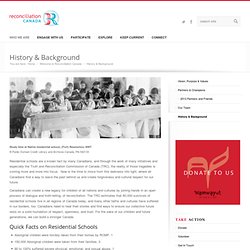
Now is the time to move from this darkness into light, where all Canadians find a way to leave the past behind us and create forgiveness and cultural respect for our future. Conditions & Mistreatment. Attendance at residential schools was mandatory for Aboriginal children across Canada, and failure to send children to residential school often resulted in the punishment of parents, including imprisonment.
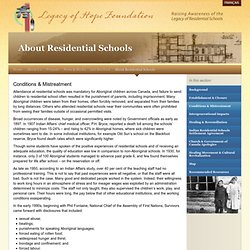
Many Aboriginal children were taken from their homes, often forcibly removed, and separated from their families by long distances. Others who attended residential schools near their communities were often prohibited from seeing their families outside of occasional permitted visits. Broad occurrences of disease, hunger, and overcrowding were noted by Government officials as early as 1897. In 1907 Indian Affairs’ chief medical officer, P.H.
Bryce, reported a death toll among the schools’ children ranging from 15-24% – and rising to 42% in Aboriginal homes, where sick children were sometimes sent to die. As late as 1950, according to an Indian Affairs study, over 40 per cent of the teaching staff had no professional training. Church apologizes to Kenora residential school survivors - Manitoba. The Presbyterian Church issued a specific apology on Wednesday to former students of a residential school in Kenora, Ont., where medical and nutritional experiments had taken place.
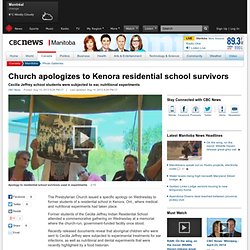
Former students of the Cecilia Jeffrey Indian Residential School attended a commemorative gathering on Wednesday at a memorial where the church-run, government-funded facility once stood. Recently released documents reveal that aboriginal children who were sent to Cecilia Jeffrey were subjected to experimental treatments for ear infections, as well as nutritional and dental experiments that were recently highlighted by a food historian. For some survivors, the latest revelations have compounded the pain they have long felt as a result of the residential school experience. "We had thought that we'd somewhat come to peace with some issues, then there's ongoing revelations of other events happening," said Richard Green, a former student who organized Wednesday's commemorative event.
Residential School Survivors' Stories Are the Key to Reconciliation. Residential School Survivors Share Their Stories. The Truth and Reconciliation Commission of Canada held a national event in Halifax October 26 to 29 at the World Trade and Convention Centre.

Everyone, both Native and non-Native, was welcome to attend. This is a report from the hearing in Eskasoni, Cape Breton. Truth can be an ugly thing. It was to hear some ugly truths that people gathered in Eskasoni on Friday, October 14th for a session of the Truth and Reconciliation Commission of Canada. Residential Schools and My Journey to the Downtown Eastside.
This post has been reviewed by the Vancouver Media Co-op editorial committee.

STORY posted on June 8, 2011 by isaac “In Our Own Voices,” Week I by DTES Power of Women GroupBy Stella August Credit: Luca Argalia. Residential Schools. Residential schools refer to a variety of institutions that include industrial schools, boarding schools and student residences.
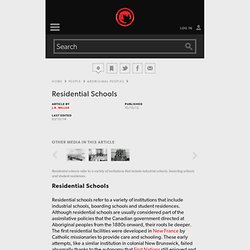
Residential Schools Residential schools refer to a variety of institutions that include industrial schools, boarding schools and student residences. Although residential schools are usually considered part of the assimilative policies that the Canadian government directed at Aboriginal peoples from the 1880s onward, their roots lie deeper. The first residential facilities were developed in New France by Catholic missionaries to provide care and schooling.
These early attempts, like a similar institution in colonial New Brunswick, failed abysmally thanks to the autonomy that First Nations still enjoyed and the Europeans' economic and military dependence on the Aboriginal population. A history of residential schools in Canada - Canada. What is a residential school?
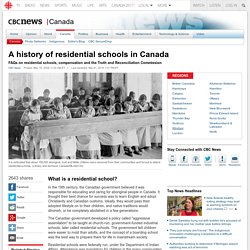
In the 19th century, the Canadian government believed it was responsible for educating and caring for aboriginal people in Canada. It thought their best chance for success was to learn English and adopt Christianity and Canadian customs. Ideally, they would pass their adopted lifestyle on to their children, and native traditions would diminish, or be completely abolished in a few generations.
The Canadian government developed a policy called "aggressive assimilation" to be taught at church-run, government-funded industrial schools, later called residential schools. The government felt children were easier to mold than adults, and the concept of a boarding school was the best way to prepare them for life in mainstream society. Residential schools were federally run, under the Department of Indian Affairs.
The Residential School System. Children's dining room, Indian Residential School, Edmonton, Alberta.
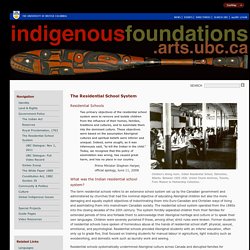
Between 1925-1936. United Church Archives, Toronto, From Mission to Partnership Collection.